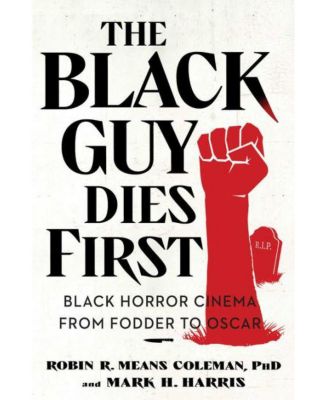The Black Guy Dies First- Black Horror Cinema from Fodder to Oscar by Robin R. Means Coleman
Product Details
Web ID: 18023743Great book for people who love horror movies
This book covers the history of Black horror films and is hilarious much of the time, but includes serious subjects. I recommend it highly, particularly for film buffs. I learned some things that surprised me and made me think. I had never thought of the impact of the Civil Rights Act on movies, for example, or realized that the Black comic relief person didn't die. Prissy in Gone with the Wind is an example of a comic relief person. ("I don't know nothing 'bout birthing no babies!") Incidentally, the first black person to win an Oscar was the woman who played Mammy from that same movie, in 1940. One of the most interesting topics to me was censorship in the early years. The top executives of the film industry created their own self-censorship - a Production Code that set guidelines for how much violence/blood/gore, nudity and sex could be shown on TV and movies. That Production Code was used for 30 years, before the Supreme Court disallowed it - and didn't put anything in its place. According to the book, this is why we have film classics like 'Psycho' which would not have been possible before. There are other sections where the author gives ratings. One rating was for actors who died in the movies, sometimes in gruesome and hilarious ways. In one example, a man was speared on a toilet while singing doo-wop. I also learned quite a lot, not just about black participation in movies, but about black history in the United States. While the book made me laugh, it also made me think. One of the serious points that the book makes is that black experience - past and present - is the origin of black horror, that black history is about genocide. I had also never thought of the black experience as including diaspora, but of course it does - just not always voluntarily. I received a review copy from the publisher Gallery Books via NetGalley, and voluntarily read and reviewed this book.
Recommends this product

Customer review from barnesandnoble.com
A fun and informative ride through horror history
In 1968, the horror movies Spider Baby, and Night of the Living Dead, came out. One marks the influence of an era gone by, while the other one heralds in a new age: one where Black actors begin to play the brave and intelligent hero. At the beginning of Spider Baby, an unnamed messenger--played by veteran actor Mantan Moreland--is trying to deliver a letter to the Merrye House: a secluded and dilapidated home that the locals avoid. However, unnamed-messenger-guy has a job to do. When his knocking goes unanswered, unnamed-messenger-guy does a horror movie no-no and peers through an open window. Big mistake, sacrificial unnamed-messenger-guy. We have just experienced the expected demise of the classic spook character: the jittery, comedic, and wide-eyed black guy who dies first. By the time Spider Baby came out, Mr. Moreland had played this same character in several horror films made mostly in the 1940s. The spook character continues through horror cinema, but it becomes slightly less cringeworthy. In Night of the Living Dead, Ben—Duane Jones’ first feature film—shows up in the second act of the movie. The film begins with white brother and sister that—while laying flowers at a grave--are attacked by the living dead (“They’re coming to get you Barbra.”). Barbra makes it to a house where she finds Ben. Ben is a strong, decisive, and brave leader who just happens to be a Black man. He manhandles the sniveling and catatonic Barbra; slapping her at one point to get her to snap out of her own version of being the living dead. He works hard for all of them to survive, and he is not the first to die. The Black Guy Dies First: Black Horror Cinema from Fodder to Oscar is an in-depth look into the history of Black characters and horror cinema from 1968 to the present. The book covers stereotypes (spook, savage, witch doctor, magical, sacrificial); Woke Horror (addressing racial and social issues); religion (belief systems, primitivism); horror/comedy (self-referential); and the effect of increased representation behind the cameras. Each section provides lists of movies and actors specific for the subject matter. There is also a lot of humor, and the tone is conversational. The Black Character Horror Movie Survival Guide (found in chapter one) provides tips such as: stay away from White people; be funny; don’t be annoying; and be famous, preferably as rapper of some sort. I’d like to end with this quote from the Epilogue: “Black horror’s triumph is its ability to reflect more deeply on the ways in which Black history has been and continues to be Black horror.” I would like to thank NetGalley and Galley/Saga Press for the opportunity to read and review this amazing book.
Recommends this product

Customer review from barnesandnoble.com
humorous and informative!
Whether a fan of horror movies or Black cinema, The Black Guy Dies First is both humorous and informative…or rather humorously informative. Authors Robin R. Means Coleman and Mark H. Harris do a wonderful job of exploring the journey and evolution of the Black experience in cinema, specifically horror, from being background characters, stereotypes, cannon fodder to where it is today: the cutting edge of horror, both entertaining as well as being a thought provoking social commentary on race in present day. I kept a notepad on hand while reading, making a list of movies I hadn’t yet seen but am now working my way through, and it’s made me view many movies I’ve already loved in a new light. Thanks so much to Gallery Books, Gallery / Saga Press and NetGalley for allowing me access to an eARC of this wonderfully entertaining and informative book.
Recommends this product

Customer review from barnesandnoble.com

